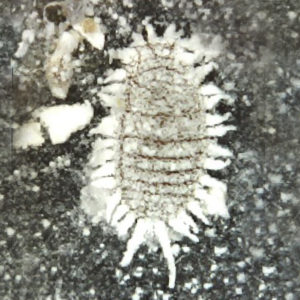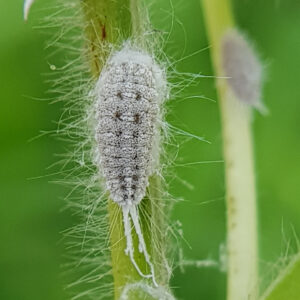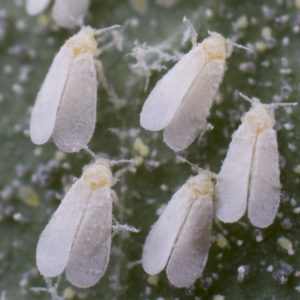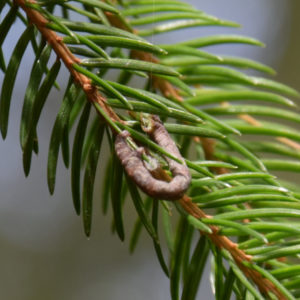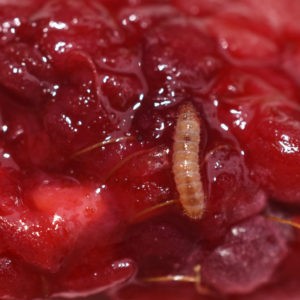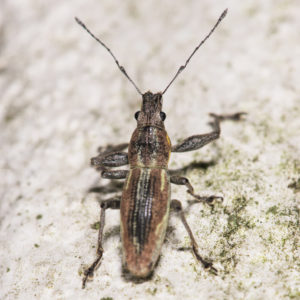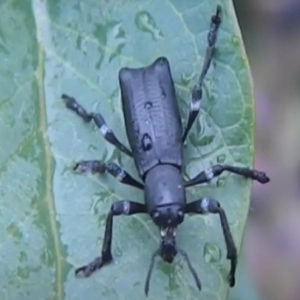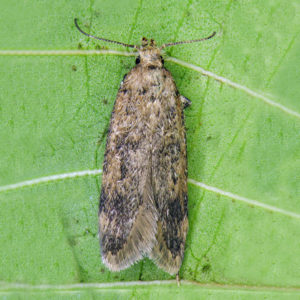There are many species of Aphids (green peach aphid, cotton aphid, potato aphid, cannabis aphid, rice root aphid, foxglove aphid), while some are host specific (monophagous), others feed on many plant species (polyphagus). There are different traits which help identify aphids: head shape, siphunculi (a pair of tube like protrusions at the posterior side of the body) size and angle and cauda (a sort of “tail” at the posterior of the body through which honeydew is secreted) size and length. Aphids come in many colors (white, black, brown, gray, yellow, light green, or even pink) and can also vary considerably within the species. Aphids possess siphunculi, used to secret a waxy substance in order to repel or deter potential natural enemies. The siphunculi, which vary in length, position and angle are also used to identify aphid species. The morphology of aphids helps, in most cases, identify the aphid species or genus, thus scouting and identification are key to using appropriate control strategies.
Cannabis aphid
The cannabis aphid (Phorodon cannabis) is pale yellow and later turn light green or pink with darker green stripes running the length of the body.
Cotton aphid
The cotton aphid (Aphis gossypii) is found on more than 700 plant species.
Black citrus aphid
The black citrus aphid is a viviparous species, which only reproduces by parthenogenesis. Under optimal conditions (temperature between 22°C to 25°C) the duration of the cycle from nymph to adult female, is of around one week, which can cause several generations during the year. This aphid is active in temperatures ranging from 7°C to 32°C. Females may be wingless or alate (with wings) and their body, siphunculi and cauda are dark-brown to black. Very susceptible to dry weather, their development ceases above 32°C.
Blackberry aphid
The large blackberry aphid are host specific, they are pale or yellowish green with pale cornicles. The body length is 2-5 mm and the cauda is short and triangular. Adults may be winged and wingless. Blackberry aphids feed on the young growth and can quickly damage young plants. Aphid colonies can lead to the decline of plants and reduce yield, if left unchecked.
Foxglove aphid
The foxglove aphid (Aulacorthum solani) is also known as the glasshouse-potato aphid; yellow to pale green, it is capable of infesting a wide variety of ornamental and vegetable plants.
Green peach aphid
The green peach aphid (Myzus persicae) can be yellowish-green, red, or brown in color because of morphological differences influenced primarily by the host plants, nutrition and temperature.
Potato Aphids
Potato aphids (Macrosiphum euphorbiae) prefer feeding on plants in the Chenopodiaceae family. They can appear green or reddish-pink; may be winged or wingless and have a preference for Solanaceae plants (potatoes in particular) yet have been identified in many vegetable and ornamental crops; therefore, scouting and identification are key.
Rice root aphid
Rice root aphids (Rhopalosiphum rufiabdominalis) also known as the red rice root aphid, prefer soil and media surroundings, making it difficult to detect. They can appear dark green to brown with yellow or red tinges and like most aphids, may be winged or wingless. The winged rice root aphid will emerge to colonize new plants. Female rice root aphids give live birth to genetically identical daughter offspring that mature quickly. Nymphs and adults feed on all plant development stages.
Spirea aphid
The spirea aphid also known as Aphis citricola van der Goot, can range from a bright greenish-yellow color to an apple green while the head, siphunculi and cauda are brown-black. This pest reproduces by viviparous parthenogenesis, each female giving birth to about 60 progeny when feeding on foliage.
Tobacco aphid
The tobacco aphid (Myzus persicae subsp. nicotianae), a key pest in tobacco crops is also encountered in a wide range of greenhouse crops such as sweet pepper, eggplant, chrysanthemum and ornamental crops.
Spider mites
There are many species of spider mites (around 1,200 species) all belonging to the family Tetranychidae. They generally prefer living in the undersides of leaves, where they spin protective silk webs which are also used as a means to protect their colonies as well as to travel from plant to plant. Spider mites can be difficult to spot but if unchecked, later move to the upper leaves. Spider mites vary in color, thus scouting and identification are key.
Avocado red mite
The avocado red mite (Oligonychus yothersi) is native to Central America. The female is orange and blackish red. The male is smaller, slender, paler in color and has longer legs than the female. The avocado red mite is a pest of great importance in avocado. Infestations occur on the mature leaves and on the upper side of the leaves, preferring to position themselves along the midrib where the eggs, nymphs and adults are grouped and protected by thin webs of whitish threads. Affected avocado leaves turn coppery-red. The attacks of this species increase from summer to autumn-winter.
Brown mite
The eggs of the brown mite (Bryobia rubrioculus) are round, bright red in color, and lack a pedicel. The adult’s body is oval and flattened, reddish-brown or greenish in color, with very long front legs. Reproduction is parthenogenetic (there are no males). It is a quarantine species
Broad mites
The broad mite (Polyphagotarsonemus latus), is a small species of mite found on many species of plants, including important agricultural crops such as grapes, cannabis, sweet pepper, chili peppers, eggplant, cucumber, ornamentals and others. The mite’s oval-shaped eggs are laid on the underside of the leaf or on fruit surfaces. The mites prefer areas of high humidity and low temperature and are a major pest in greenhouses.
Chilean false Red Mite
The Chilean false red mite is so called because it resembles spider mites but its body is much flatter. Brick-red in color with black dorsal spots, the adult female is about 0.8 mm in length. The B. chilensis is made up of mostly female individuals and produce offspring without fertilization. The eggs are red, ovoid and shiny. The short ambulatory appendages are very short; therefore it has low mobility. It is an important pest in vineyards, especially red wine cultivars, where it causes the death of shoots due to dehydration, tanning, wrinkling of leaves and dehydration of pedicels and rachis. This can translate into more than a 30% loss of production. It also affects some varieties of table grapes. It is mainly found in Chile.
Citrus red mite
Adult Citrus red mites (Panonychus citri) are dark red, bordering on purple and their eggs are also dark red. The mites disperse by holding on to a silken thread they produce, and floating on air streams. The citrus red mite is most often associated with citrus but may infest pears, almond, roses and other broad-leaved ornamentals.
Cyclamen mite
Cyclamen mite (Phytonemus pallidus) are tiny mites (less than 0.5mm long) that feed on plant sap by penetrating the plant tissue with its piercing-sucking mouth parts. The mites are mostly found on the underside of leaves, within the flower buds, growing tips and young folded leaves, away from direct sunlight.
European red mite
The European red mite (Panonychus ulmi), also known as the fruit tree red mite attacks fruit trees but can also be a problem in grape vines, ornamentals and roses. The European red mite does not produce large amounts of webbing like the two-spotted spider mite (Tetranychus urticae). The female lays its eggs on the leaves and overwinters in the egg stage. In temperate climates, the “winter eggs” are laid in the wooden parts of the host plants in autumn.
Persea mite
The persea mite (Oligonychus perseae), originally from Central-America, is green-yellow with darker spots on the hysteronotum. This mite is a serious pest in avocado, living and feeding within small webbed nests along the main veins, on the underside of leaves
Carmine spider mite
Red spider mite usually favor the underside of leaves and can cause the leaves to curl downwards and often, the leaves turn yellow on the upper side (of the leaves), directly opposite the feeding area.
These mites can also be found on the fruit. Fine strands of webbing may be noted in infested areas. Red spider mite can cause russeting or browning of the fruit (similar to rust mite damage), which, if severe, can result in economic loss at harvest time. If the infestation is left untreated, red spider mite can cause defoliation.
Russet mite
There are many species of russet mites: the tomato russet mite (Aculops lycopersici), the citrus russet mite (Phyllocoptruta oleivora), the hemp russet mite (Aculops cannibicola) and many others. Adults and nymphs may appear white, tan, pink or yellow and are almost invisible to the naked eye. Russet mites do not produce the webbing, thus may go unnoticed until there is a build-up of a large population as well as visible damage.
Southern Red Mite
The southern red mite (Oligonychus ilicis) also called the coffee red mite, produces several generations per year. The adult female is 0.38 mm in length with aa rotund-elliptical body. Oligonychus ilicis are reddish brown and darker than most red spider mites, while the frontal area is more translucent.
Table-grape red mite
The table grape red spider mite is small with an oval, globose body. The front part of the body and legs are red-orange while the back is dark red. Eggs are spherical, orange-red to dark red in color with a white dorsal pedicel (hair). They prefer the base of buds or cracks and spend the winter in the egg stage. Subsequently, at the beginning of spring hatching begins, causing the population to infect shoots and leaves. Each generation takes 18 to 24 days to develop.
Two-spotted spider mite
Two-spotted spider mite (Tetranychus urticae) is oval and has two dark spots on either side of the body. This mite may be brown, orange-red or greenish-yellow in color. Two-spotted spider mite lays its eggs on the leaves. It attacks well over 100 species of cultivated crops and weeds and is a serious pest on peppers, tomatoes, strawberries, cucurbits and other vegetables, ornamentals, flowers and fruit trees.
Mealybugs
Mealybug is a pest which can have a considerable negative economic impact on a wide range of ornamental and agricultural crops. Since there are many species of mealybugs, scouting and identification are crucial. Sexually dimorphic, adult female mealybugs are much larger, retain the appearance of younger stages and lack wings while the adult males are much smaller and develop into mosquito-like insects with wings.
Citrus mealybug
The citrus mealybug (Planococcus citri) can be recognized by a slightly darker, longitudinal, dorso-median stripe and it’s orange-brown color with medium length wax filaments at the body margins. The adult female lays amber-yellow eggs in a fluffy posterior ovisac.
Cotton mealybug
The cotton mealybug (Phenacoccus solenopsis) has two broken grey sub-median longitudinal stripes and very short lateral wax filaments.
Delottococcus mealybug
The delottococcus mealybug is a species of mealybug that causes deformation in citrus fruit. They can have a considerable negative economic impact on a wide range of crops and ornamentals.
Grape mealybug
The grape mealybug (Pseudococcus maritimus) is brown to pink in color with a thin mealy wax covering, sometimes with faint, wide dorso-medial line and a pair of posterior wax filaments that are unusually straight. It can have a considerable negative economic impact on a wide range of crops and ornamentals.
Spherical mealybug
The spherical mealybug, also known as the Karoo thorn mealybug, has five to six pairs of short lateral filaments, becoming steadily longer posteriorly, the caudal pair is slightly longer than the antennae. This mealybug can have a considerable negative economic impact on a wide range of crops such as citrus coffee, mango, cotton, soybean, avocado and sweet thorn tree.
Longtailed mealybug
The longtailed mealybug (Pseudococcus longispinus) is easily recognizable by its broad dorso-medial line and 4 very long posterior tails as well as the long lateral wax filaments. This particular mealybug gives birth to live nymphs and does not produce egg masses.
Obscure mealybug
The obscure mealybug (Pseudococus viburni) has two extra-long, thin posterior wax filaments and their honey dew droplets are yellow to orange. It can have a considerable negative economic impact on apples and pears.
Papaya mealybug
The papaya mealybug (Paracoccus marginatus) belongs to the Pseudococcidae family. Adult females have yellowish bodies covered with a white waxy coating that is usually thinner between the segments giving the body a slightly barred appearance. The lateral waxy filaments are short. The elongated oval body of the adult female is 2.0 to 3.5 mm long while the adult male is very small, winged and pink in color. Upon maturation, the papaya mealybug begins to secrete white, elastic, sticky wax filaments from the edges of its abdomen to form a protective ovisac for its yellow eggs. The ovisac can be up to twice as long as the body.
Pseudococcus meridionalis
Fairly newly discovered, thisFairly newly discovered, this Pseudococcus meridionalis mealybug has an elongated, oval, pinkish-purple body. Its ostiolar secretion is reddish. It has cylindrical, clavate-shaped lateral filaments, its caudal filaments can reach 90% of the length of its body, and its eggs are orange. has an elongated, oval, pinkish-purple body. Its ostiolar secretion is reddish. It has cylindrical, clavate-shaped lateral filaments, its caudal filaments can reach 90% of the length of its body, and its eggs are orange.
Oleander mealybug
The Oleander mealybug (Paracoccus burnerae) is elongated with visible body segmentation and can have a considerable negative economic impact on citrus.
Striped mealybug
The striped mealybug (Ferrisia virgata) is a pest of a broad range of plants. The two dark dorsal stripes that run longitudinally along its body, visible through bare patches on the waxy covering gave it its name. Additional identifying features are two posterior waxy tails, half the length of the body and the presence of hair-like crystalline hairs extending laterally from the body.
Citrophilus mealybug
The Citrophilus mealybug (Pseudococcus calceolariae), also known as the scarlet mealybug, has pronounced wax exudation on the median line which gives it a slight humped back appearance and their honeydew droplets are wine-red. It can have a considerable negative economic impact on apples and pears. DAMAGE A high population of mealybugs can lead to: fruit […]
Vine mealybug
The vine mealybug (Planococcus ficus) can be identified by a dark thin dorso-medial line of denuded wax; it can be found on roots as well as above ground. DAMAGE A high population of mealybugs can lead to: fruit drop, fruit deformation and development of discolored welts on the rind of the fruit. Mealybug secrete copious […]
Thrips
There are many species of thrips, approximately 6,000 species have been described by entomologists. Thrips are worldwide pests with a wide range of host plants, the main ones being vegetable crops, field crops, flowers, fruit trees, citrus and many ornamental plants. Some thrips are predators of other insects or mites, thus scouting and identification are crucial.
Chilli Thrips
Chilli thrips (Scirtothrips dorsalis) is a widely distributed pest with a broad range of host plants, including pepper, mango, citrus, strawberry, grapes, cotton, tea, blueberry and roses. The chilli thrips is a small insect (< 2mm) with a narrow body and tightly folded wings forming a dark stripe along the lower abdomen. Field identification is difficult both because of its size and the rapid movement.
Onion thrips
Tobacco thrips (Frankliniella fusca) is a worldwide pest with a wide range of host plants. The tobacco thrips is a small insect with a narrow body; females are usually brown or black and the males are yellow, having eight segmented antennae. Some are winged (macropterous) and other aren’t (brachypterous).
Tobacco thrips
Tobacco thrips (Frankliniella fusca) is a worldwide pest with a wide range of host plants. The tobacco thrips is a small insect with a narrow body; females are usually brown or black and the males are yellow, having eight segmented antennae. Some are winged (macropterous) and other aren’t (brachypterous).
Western flower thrips
The western Flower Thrips (Frankliniella occidentalis) is a worldwide pest with a wide range of host plants. A year-round invasive pest, they are less destructive during wet weather. The western flower thrips is a small insect with a narrow body (up to 1.2 mm in length) and yellowish in color.
Whiteflies
Whiteflies are small sap-sucking insects that typically feed on the undersides of plant leaves and can inflict direct and indirect damage to a wide variety of crops and ornamentals.
Greenhouse whitefly (GHW)
The greenhouse whitefly (Trialeurodes vaporariorum), sometimes referred to as the glasshouse whitefly, prefer to lay their eggs on the undersides of leaves.
Sweet-potato whitefly (SPW)
The sweet-potato whitefly (Bemisia tabaci) is sometimes referred to as the silverleaf whitefly. Outbreaks of sweet potato whitefly occur worldwide, resulting in yield loss and economic injury in a wide array of crops.
Leafminer
There are numerous species of leaf miners: the American serpentine leaf miner, the tomato leaf miner, the pea leaf miner as well as insects in which the larval stage lives in and nourishes itself from the plants leaf tissue.
Chrysanthemum leaf miner
Adults Chrysanthemum leaf miners (Chromatomyia syngenesiae) are small, black to gray flies with yellow markings. The females puncture leaves to feed on plant sap and lay eggs within the leaf tissues. The larval stage lives in and nourishes itself from the plants leaf tissue.
Tuta Absoluta
Tuta absoluta, also known as the tomato leaf miner, tomato pinworm and South American tomato moth, is a major pest of field and greenhouse-grown tomatoes. Adult moths are grey-brown, while newly hatched caterpillars are yellowish and small.
Mediterranean fruit fly
The Mediterranean fruit fly (Ceratitis capitata), also known as the Medfly, is among the most economically important fruit fly species because of its ability to survive in cooler climates and to infest hundreds of tropical fruits and vegetables, causing severe degradation and economic loss.
Olive fruit fly
The olive fruit fly (Bactrocera oleae) lays its eggs in the fruit of olive trees by making a puncture with the ovipositor into the skin of the olive. The puncture is dark green to begin but changes to a yellowish-brown color as a result of the wound inflicted.
Diamondback moth
Diamondback moth (Plutella xylostella), sometimes known as the cabbage moth, are widespread pests of brassica crops. Adults are small slender grey-brown moths with a lighter band along its back which forms a diamond shape, from where they get their common name. Larvae are green and develop through four instars in about 3 to 4 weeks. The diamond moth eggs are oval and flattened, yellow or pale green in color. The females lay eggs only on the leaves of the Brassicaceae family. While the larvae are colorless in the first instar, they are pale or emerald green with black heads in later instars. Pupation occurs in a loose silk cocoon which are usually found on the lower or outer leaves of the host plant. Diamondback moth can undergo several generations in a crop cycle and form high populations if not controlled at an earlier stage. Moths can migrate long distances on the wind and also migrate between adjacent fields.
Spruce budworm
The spruce budworm is a small brown moth which lays its eggs on balsam fir, white spruce and sometimes red and black spruce. Newly hatched larvae make nests in protected areas where they overwinter. Feeding commences in the spring with defoliation becoming apparent later in the summer.
Leek moth
The Leek moth (Acrolepiopsis assectella) also known as the onion leaf miner is an invasive species in North America that attacks leeks and related Allium species.
The female lays eggs on the leaves of the host plant. The larvae are light yellow-green in color with a brownish head. The first instar larvae form leaf mines, shaped like a corridor which then turns into a blotch and can be with or without frass.
Cabbage white
Cabbage white (also called imported cabbageworm or cabbage butterfly) are white butterfly with darker wing tips and eyespots in the forewings.. The larvae feed primarily on brassica plants with some secondary hosts in related families, e.g. Capparidaceae, Resedaceae. P. rapae eggs are yellowish with 12 longitudinal ridges. The caterpillars are bluish-green in color with tiny black pints, a lateral row of yellow dashes and a yellow middorsal line. During the pupal stage the cabbage white is brown-grey or yellowish (matching the background).
Cabbage looper
Cabbage loopers (Trichoplusia ni) is a type of cabbage worm that attack cruciferous vegetables, including cabbage, bok choy, broccoli, beans, lettuce, cotton as well as ornamental plants such as chrysanthemum. The eggs are generally yellow-white in color, dome-shaped and patterned with ridges. The larvae are pale green, often with a white stripe along the side and have a distinctive looping walk, from which they get their common name. Pupation occurs in the undersides of leaves, where they form a silky cocoon. Adults are medium sized brown moths and can undergo several generations in a crop cycle.
Cabbage loopers can inflict various kinds of damage on a crop.
Cutworms
Cutworms are the larval stage of certain owlet moths that hide in the soil during the day and feed on plants at night. Although the eggs vary in color, they all have a spherical shape. The larvae have a smooth appearance with green, brown, grey or yellow colors and the pupae, most often, range from shiny brown to dark brown. The adults are medium sized brown or grey moths. Many species of owlet moths are considered an agricultural problem around the world. As general feeders, they attack a wide range of vegetables (asparagus, beans, cabbage, carrots, corn, lettuce, peas, peppers and tomatoes) and ornamentals.
Raspberry fruitworm
The raspberry fruitworm (Byturus unicolor) is a type of fruitworm beetle in the Byturidae family. It is also known as the western raspberry fruitworm and fruitworm beetle. Adults are 4-5 mm long, small yellowish-brown oval shaped beetles. The larvae are white with darker areas on the top of each body segment and develop in the berries of various Rubus plants. When the larvaee reach maturity, they drop to the ground, burrow into the soil and pupate. Adult beetles overwinter in the soil and emerge in the spring feeding on fruit buds, young leaves and flowers.
Macadamia nut borer
The Macadamia nut borer (Thaumatotibia batrachopa) lays its eggs singly on young fruit measuring around 10mm in diameter. Females can lay between 170-300 eggs in their lifetime. On hatching, larvae bore through the skin and into the fruit in search of the seed.
European corn borer
European corn borer (Ostrinia nubilalis) also known as the European corn worm or European high-flyer has a wide host range, attacking many herbaceous plants with a stem large enough for larvae to enter. The western strain attacks corn and other vegetables before corn is available, or late season when corn becomes senescent. Crops attacked include beans, pepper, potato, cannabis, hemp, hops and oats. The adult females lay clusters of whitish-yellow eggs on the underside of corn leaves, as the eggs develop they become transparent and the black heads of the caterpillars become visible (see above picture). The larva vary in color from light brown to pinkish gray with small brown spots along the body. The adult female is light yellowish-brown with darker irregular wavy bands across the wings while the male is smaller and darker. A female can lay a total of 400 to 600 eggs during her adult life.
South American fruit tree weevil
The South American fruit tree weevil (Naupactus xanthographus) is a coleopteran with an elongated shaped body (11-15 mm in length). Newly emerged adults are reddish-brown but change to gray-brown. Thee elytra has narrow yellowish-white longitudinal bands. The elytra are broader in females than in males. Eggs are yellowish in color and are laid in masses. The apodous C-shaped larvae are white, then yellowish, and finally beige. The pupae are light colored and have free appendages.
Fuller’s Rose beetle
Fuller’s Rose beetle (Naupactus cervinus) are 8-9mm in length. the head, antennae, thorax and fused elytra are grey-brown with a pair of light brown stripes on the sides of the pronotum and a pair of oblique white stripes on the side of the elytra. The rostrum is short and conical, with protruding oval black eyes and medium-length antennae. A parthenogenetic species, presenting only one generation per season, they lay the eggs in masses adhered with secretions from the female. Eggs are yellowish in color and are laid in masses. The apodous C-shaped larvae are white, then yellowish, and finally beige. The pupae are cream-colored and have free appendages.
Raspberry weevil
The raspberry weevil (Aegorhinus superciliosus) also known as the cabrito del frambueso (in Spanish) is native to South America. A large curculionid, the adults measure 15-20 mm, their body is black with three transverse white stripes on the back, from one side of the elytra to the other. Unlike other curculionids, the face is directed downwards and not forwards. The back of the body is dark gray to black, rough and sclerotized. The legs are black, long, strong, with well-developed tarsi, the last elongated with two terminal nails which help them to climb the trees to feed on young foliage. The male is smaller and narrower than the female. Reproduction is sexual and the oval, creamy white-yellowish eggs are deposited in cracks in the trunk or attached to the ground covered by a mucilaginous substance that protects them from drying out and from predators. The larval development takes place at the trunk level and inside the roots of the host plants. Apodous, creamy white, recently emerged larva measures 0.15 cm and fully developed around 2.0 cm. Pupae are creamy white and have short brown setae, like spines.
Peach weevil
The peach weevil (Aegorhinus phaleratus) also known as the cabrito del duraznero (in Spanish) is native to Chile. The body of the adult is black, robust and covered with setae and white scales arranged in broad, transverse bands on the elytra. The pronotum is elongated, with deep, irregular punctuations. The female lays the eggs in groups of 4 or 5, on the soil or in cracks in the bark 10 cm from the ground. Hatching occurs after approximately two weeks. The larva is yellow.
Plumb weevil
The plum weevil (Aegorhinus nodipennis) also known as the cabrito del ciruelo (in Spanish) is native to Chile. It is considered a key pest in organic blueberry and European hazelnut orchards, although it can affect both fruit trees and native trees. The adult is 2 to 3 cm long, smooth and bright colored with scale areas which give it a characteristic coloration. Males are smaller than females and found in a much smaller proportions. Their yellowish-white eggs are mostly laid on the ground singly or in groups of 2-3 and covered by feces. The larvae are white with a dark head and once it reaches its latter stage, it prepares a cell inside the crown and turns into a pupa.
Black vine weevil
The black vine weevil (Otiorhynchus sulcatus), also known as the taxus weevil or cyclamen grub, is matte black with fused wing covers
Citrus root weevil
The citrus root weevil (Diaprepes abbreviatus), also known as the citrus root borer or chichi in Spanish, is black with white, red-orange or yellow stripes on the wing covers. Host plants include citrus, rambutan, sugarcane, cassava and maize.
Pepper weevil
The pepper weevil (Anthonomus eugenii) feeds and lays eggs on sweet peppers (Capsicum annum), chilli peppers (Capsicum frutescens) and other solanum species such as eggplant and tomato.
Red palm weevil
The Red Palm Weevil, also known as palm weevil, Asian palm weevil or Sago Palm Weevil, is a large weevil and widely considered to be the most damaging insect pest of palm trees in the world.
Rough strawberry root weevil
The Strawberry Weevil (Otiorhynchus rugosostriatus) is native to South America and has a wide range of both forest and fruit hosts. Strawberry weevil adults are highly distinctive, with a 0.7-0.8 cm oval, reddish-brown to black body and a globose appearance. The antennae and legs are black and hairy. The adults are parthenogenetic and so far only females have been recorded. The female lays hundreds of eggs in groups on the ground around the base of the plants, occasionally they can be laid on petioles close to the ground. The larvae emerge after about 3 weeks. The larvae feed on rootlets at the beginning and move to feed on larger roots as they grow. Larvae Pupation occurs on the ground cover.
Strawberry root weevil
The Strawberry root weevil (Otiorhynchus ovatus) gets its name from their preference for strawberry plants yet they are also known to feed on raspberry, rhododendron, grape and peppermint.
European chafer beetle
The European chafer beetle (Amphimallon majale – previously Rhizotrogus majalis) is light tan-brown in color while their C-shaped larvae, are large, whitish with a light brown colored head and six jointed legs.
Japanese beetle
The Japanese beetle (Popillia japonica) is among the most damaging scarab beetles that infest turfgrasses in North America, Canada and Europe.
Flatheaded woodborer
The flathead woodborrer (Capnodis tenebrionis and Capnodis carbonaria) also known as the Capnodis beetle is shiny grey or black colored with six patches.
Pacific flatheaded borer
The flathead woodborrer (Capnodis tenebrionis and Capnodis carbonaria) also known as the Capnodis beetle is shiny grey or black colored with six patches.
Peach Tree borer
The peach tree borer (Synanthedon exitiosa) is a pest of peach, cherry, plum, nectarine, and apricot trees. The adult peach tree borer is a type of clear wing moth and are active during the day.
White Grubs
White grubs are the larval or grub stage of several species of weevils and chafers beetles.
Black scale
The black scale (Saissetia oleae) is an important pest of citrus and olive trees. The oval, almost flat body of the female is 3.0-6.0 mm long and its shield is dark-brown to black in color, hence the name. A recognizable trait is the two transverse crests and one median ridge, which together form the letter H. The black scale reproduces by parthenogenesis. The eggs are protected under the shield until they emerge. The crawlers settle mostly along the main veins on the lower sides of leaves, young nymphs will later migrate to twigs and branches and remain there for the rest of their lives.
Pyriform scale
Pyriform scale (Protopulvinaria pyriformis) also known as heart-shaped scale, is a species of soft scale insect and a pest of avocado and ornamentals. The pear-shaped pyriform scale adult is yellowish-brown to barker brown with a characteristic white fringe.
California red scale
The California red scale (Aonidiella aurantia) gets its name from the reddish-brown scale cover it produces for protection. Males and females are visually dimorphic during development; females have a round scale covering them and males have an elongated scale.
Oriental yellow scale
Oriental yellow scale (Aonidiella orientalis) gets it’s name from the color which is almost white pale brown or yellow. The Oriental yellow scale attaches itself to a host plant, loses its legs and remains stationary, covered by a scale-like shield.
Oleander scale
The oleander scale (Aspidiotus nerii) also known as ivy scale is a Hemipteran sap sucking insect, that attaches itself to a host plant and remains stationary covered by a scale-like shield. Males and females are visually dimorphic during development; females have a round scale with an off-centered apex covering them.
Leafrollers
Leafrollers are the larvae of some tortricid moths, with bodies ranging in color from green to brown. The larvae feed and pupate within rolled-up leaves of the host plant which are tied with silk threads to provide protection. Many of the moth species adults are drab and have mottled and marbled brown colors. Several species cause problems on ornamental and fruit trees. Examples include the obliquebanded leafroller (Choristoneura rosaceana), the omnivorous leafroller (Platynota stultana) and the codling moth (Cydia pomonella) which can be important pests of fruit trees.
Codling moth
The codling moth (Cydia pomonella) is a member of the Lepidopteran family Tortricidae. Not large, they are distinguished from other moths by the golden patterns on their fore-wings: brown spots enclosed in gold, coppery bands. The codling moth young larvae are white with black heads while mature larvae are pinkish white with brown heads. The preferred host plants are apple and pear trees.
False codling moth (FCM)
The False Codling Moth (FCM) adult has patterned wings with a variation of colors (grey, brown, black and dark orange) and lays its eggs on the surface of the fruit. The FCM is nocturnal and is seldom seen in the orchard.
Burrowing nematodes
Burrowing nematodes (Radopholus similis) is a species of nematodes, a parasite of plants and a pest of many agricultural crops. The burrowing nematode is a migratory endoparasite of roots and an especially important pest of bananas and citrus yet can also be found on coconut, avocado, coffee, sugarcane, ginger and ornamentals.
Cyst nematodes
Cyst nematodes are 1-mm long roundworms that belong to the genus Globodera (which comprises around 12 species). They live on the roots of plants of the Solanaceae family. PCN cause growth retardation and, at very high population densities, damage to the roots
Reniform nematodes
Reniform nematodes (Rotylenchulus reniformis) are a semi-endoparasitic (the body is partially inside the roots) species in which the females penetrate the root cortex, establish a permanent-feeding site in the stele region of the root and become sedentary or immobile.
Plant-parasitic nematodes (PPN)
The plant-parasitic nematodes are soil-dwelling pests that feed from the roots of a host plant, although some also feed on the upper parts of plants in flowers, seeds or shoot tissues.



































